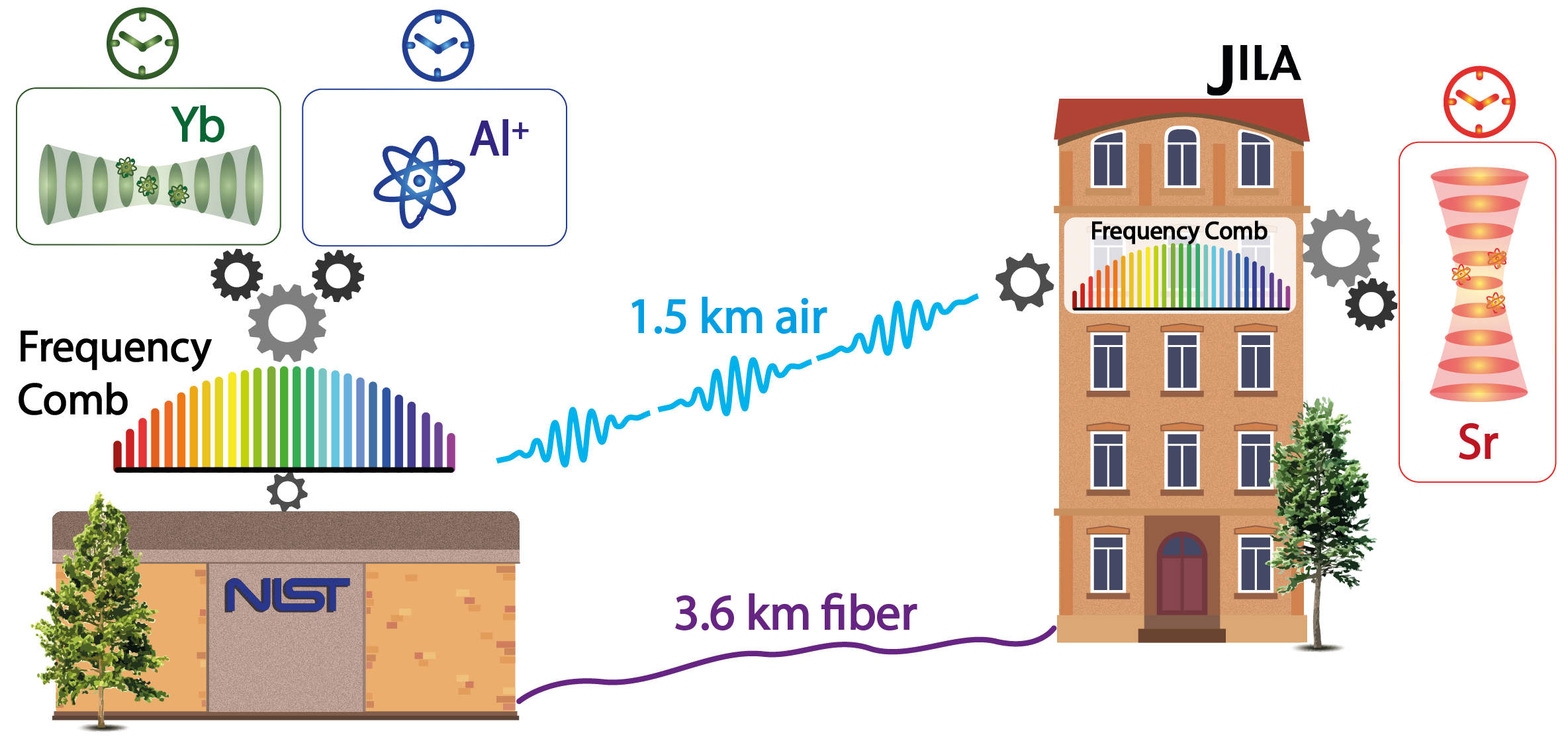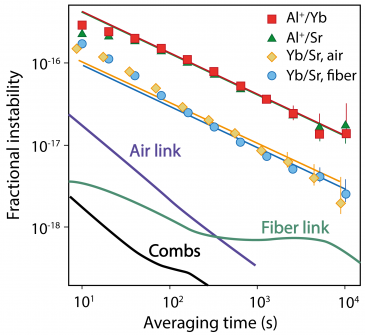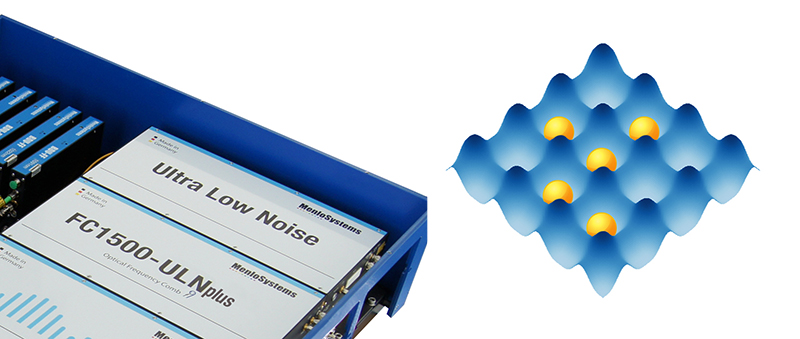Menlo Systems product:
Original publication:
Record accuracy in optical clock networks
A group of researchers organized in the Boulder Atomic Clock Optical Network (BACON) Collaboration compare three optical atomic clocks based on different atoms with record accuracy. At JILA, they employ Menlo Systems' FC1500-ULNplus for transferring the purity of the silicon cryogenic cavity to the strontium clock laser.
Optical clocks are the last and most-accurate generation of devices to keep track of time. As time standards, they make use of very narrow atomic transitions at optical frequencies that are probed by ultrastable lasers. These so-called “local oscillators” oscillate so rapidly that their oscillations cannot be detected by traditional electronic instruments. For this reason, femtosecond frequency combs are used as synthesizers, transforming optical frequencies into electronically detectable microwaves.

Figure 1: System overview of the Boulder Atomic Clock Optical Network (BACON). The figure shows NIST and JILA facilities. Top left: The two optical clocks (Al+ and Yb) at NIST; Top right: The Sr lattice clock located at JILA. Stabilized light from the Sr lattice clock is transferred to NIST via a 3.6-km optical fiber link (wavy violet line) for a frequency comparison with the Al+ and Yb clocks. The Yb and Sr lattice clocks are also compared using optical two-way time-frequency transfer via a 1.5-km free-space optical link (blue line) between the two institutions. Adapted from [1].
In comparison to their microwave counterparts, the stability of optical clocks outperform that of the best cesium clocks by two orders of magnitudes. However, the lack of reproducibility of this performance and of open-air links were, up to now, obstacles to considering them as the next candidates for the redefinition of the SI second.
Scientist from the Boulder Atomic Clock Optical Network (BACON) Collaboration have recently reported clock comparisons with record reproducible accuracy at the 10-18 level. This network (see Fig. 1) involved three state-of-the-art optical clocks located in Boulder: the 27Al+ and 171Yb at NIST and the 87Sr at JILA, the latter one relying on a frequency comb from Menlo Systems.
Comparisons were quantified through fractional ratio uncertainties when using both a 3.6 km fiber link and a 1.5 km free-space link. Results show uncertainties below 8 × 10-18 for each of the three combinations (Al+/Sr, Al+/Yb, and Yb/Sr) and ratios that are consistent with CIPM (Comité International des Poids et Mesures, the International Committee for Weights and Measures) recommended clock frequency values. Moreover, the simultaneous measurements using both links test the network independently of the clocks. The reported stability is a very exciting finding that broadens the use of optical clocks outside the laboratory. Possible applications are corroborating Einstein’s theory of relativity in-field – since gravity variations due to altitude can be detected with these clocks with cm resolution, or improving the accuracy of satellite communications where up to now microwave atomic clocks are employed.
Additionally, as frequency ratios are sensitive to changes in fundamental constants, the authors applied and used these comparisons to analyze more thoroughly the current model of the composition of dark matter. More specifically, they improved by an order of magnitude the constraints on the modulus that describes the coupling of dark matter and the electromagnetic field. This shows the utility of optical clocks outside metrology to also test theories beyond the standard model.

Figure 2: Fractional instability in the ratio measurements (points; see key) and network components (labelled lines) as a function of averaging time. The plot shows the instability of the free-space and fiber links between JILA and NIST, and the optical frequency combs used in the measurement. All data are analyzed using the overlapping Allan deviation. Matching lines to the ratio data are weighted fits using a white frequency noise model, beginning at a 100-s averaging time. Error bars indicate 68 % confidence intervals. Adapted from [1].
Reliable performance of these optical clocks is only possible if the network components do not present limiting factors. In consequence, the very first set of measurements reported was meant to check the ultimate instability of these components. Notably, the researchers show that the frequency combs involved in the network, one of which was manufactured by Menlo Systems, do not deteriorate the optical links with instabilities well below 10-18 for averaging times above 10 s (see Fig. 2).
Once more, this work proves the versatility of optical clocks as both, a new time standard and a device enabling the testing of fundamental physics. Commercial realization of such devices can be foreseen in the near future thanks to the continuous development and improvement of the clocks’ key components. One of them is Menlo Systems’ FC1500-Quantum, a complete CW laser system with optically referenced frequency comb, paving the way towards compact complete solutions that bring quantum technologies into real application and the redefinition of the SI second a step closer.
Author: Sandra de Vega
Original publication:
[1] BACON Collaboration: Frequency ratio measurements at 18-digit accuracy using an optical clock network; Nature 591, pp. 564 – 569 (2021)
DOI: https://doi.org/10.1038/s41586-021-03253-4
